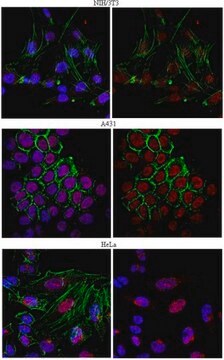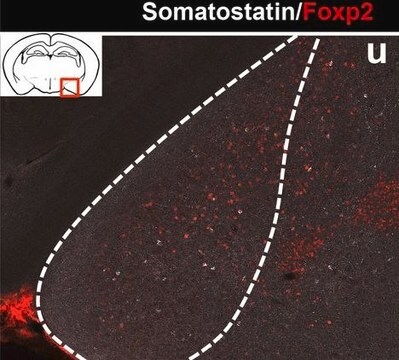MABE419
Anti-m3G-cap, m7G-cap Antibody, clone H-20
clone H-20, from mouse
Synonyme(s) :
Anti-m3G/m7G-cap, Clone H-20 Anti-m3G-cap, m7G-cap Detection Antibody
About This Item
Produits recommandés
Source biologique
mouse
Niveau de qualité
Forme d'anticorps
purified immunoglobulin
Type de produit anticorps
primary antibodies
Clone
H-20, monoclonal
Réactivité de l'espèce (prédite par homologie)
all
Technique(s)
dot blot: suitable
immunocytochemistry: suitable
immunoprecipitation (IP): suitable
western blot: suitable
Isotype
IgG1κ
Conditions d'expédition
wet ice
Modification post-traductionnelle de la cible
unmodified
Description générale
Immunogène
Application
A representative lot from an independent laboratory detected m3G-cap in m3G-capped snRNAs from HeLa nuclear extracts (Bochnig, P., et al. (1987).
A representative lot from an independent laboratory immunoprecipitated m3G-cap from prefractionated HeLa S100 extracts (Huber, J., et al. (1998).
A representative lot from an independent laboratory detected m3G-cap in m3G-capped U1 snRNPs from digitonin permeabilized HeLa cells (Bochnig, P., et al. (1987). Eur J Biochem. 168(2):461-467.).
Épigénétique et fonction nucléaire
Biologie de la chromatine
Qualité
µ
Forme physique
Stockage et stabilité
Recommandations relatives à la manipulation du produit : dès réception, et avant le retrait du bouchon, centrifuger le flacon et mélanger délicatement la solution. Répartir en aliquotes dans des microtubes à centrifuger et conserver ces derniers à -20 °C. Éviter les congélations/décongélations répétées, qui peuvent détériorer les IgG et nuire aux performances du produit.
Autres remarques
Clause de non-responsabilité
Vous ne trouvez pas le bon produit ?
Essayez notre Outil de sélection de produits.
Code de la classe de stockage
12 - Non Combustible Liquids
Classe de danger pour l'eau (WGK)
WGK 1
Point d'éclair (°F)
Not applicable
Point d'éclair (°C)
Not applicable
Certificats d'analyse (COA)
Recherchez un Certificats d'analyse (COA) en saisissant le numéro de lot du produit. Les numéros de lot figurent sur l'étiquette du produit après les mots "Lot" ou "Batch".
Déjà en possession de ce produit ?
Retrouvez la documentation relative aux produits que vous avez récemment achetés dans la Bibliothèque de documents.
Notre équipe de scientifiques dispose d'une expérience dans tous les secteurs de la recherche, notamment en sciences de la vie, science des matériaux, synthèse chimique, chromatographie, analyse et dans de nombreux autres domaines..
Contacter notre Service technique







